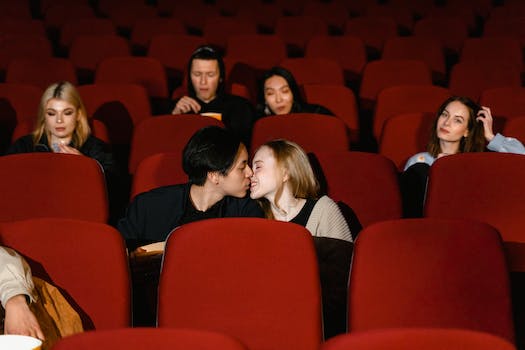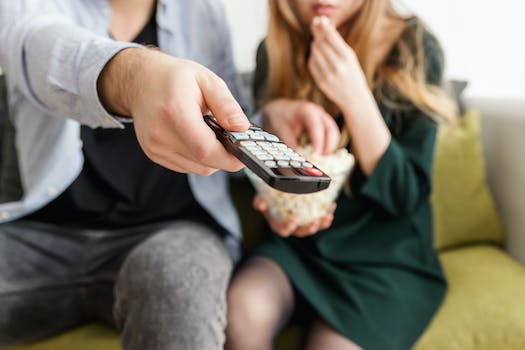Movies on romantic relationships have always been able to captivate viewers all around the world. There always appears to be some sort of romantic subplot in movies, whether they are period pieces or contemporary romantic comedies. Yet, have you ever pondered why? Explore the many facets of romance that have made it such a staple of film throughout the years, and learn why it continues to be such a popular story element.
- 1. Introduction
- 1.1. Exploring the popularity of romance in movies
- 1.2. The universal appeal of love stories
- 1.3. The impact of romance on audience engagement
- 1.4. The role of romance in storytelling
- 1.5. Understanding the fascination with on-screen chemistry
- 2. Cultural Influences
- 2.1. Romantic ideals and cultural norms
- 2.2. Societal expectations and romantic narratives
- 2.3. The influence of romantic literature and art
- 2.4. Romanticism in different cultures
- 2.5. The portrayal of romance in different film industries
- 3. Emotional Connection
1. Introduction
Movies have long been a favorite past time because of the way they tell stories and impress their viewers with special effects. Romance is one theme that may be seen in movies of all kinds. There is always a love story woven throughout the plot of a movie, whether it’s a comedy, a drama, or an action flick. But have you ever pondered why love stories feature so prominently in the movies? This article will discuss the importance of romantic subplots in films and the factors that make them so common.
1.1. Exploring the popularity of romance in movies
Movies on romantic relationships have always been able to captivate viewers of all ages and walks of life. The portrayal of love and relationships in film, whether in a period piece or a contemporary romantic comedy, is highly popular.
The power of romance to make audiences feel something is one of the genre’s most appealing qualities. The experience of love is universal to all humans, making it a great subject for cinematic exploration. It gives its viewers a sense of optimism and hope by transporting them to a world of desire, longing, and connection.
Romance is also a great way to ramp up the drama and suspense in a novel. The twists and turns that occur inside a romantic relationship frequently act as the story’s engine, making the audience care about what happens. Audiences can be captivated by stories of the ups and downs of a couple’s love story, from the first spark of passion to any subsequent problems.
Movies with a romantic plot offer an opportunity to have some of your dreams come true. Many people want to live vicariously via the characters on screen, and they do so by watching movies about epic love stories and meeting their soul mates. It’s entertaining because it lets people escape reality and live out their wildest dreams about love at first sight and happily ever after.
Last but not least, romance is a genre that can be enjoyed by people of many backgrounds. Love transcends boundaries of language and culture, making films about romantic relationships accessible to a wide audience. No matter the context,
1.2. The universal appeal of love stories
People all across the world have long been drawn to tales of undying love. The presence of romantic elements in fictional works is a consistent trend across media. But why does every film have some sort of romance subplot? Why do we become so invested in tales of love?
One possible explanation is that romantic love appeals to our most fundamental feelings. Most people can identify to the experience of love because it is so fundamental to being human. Whether it was romantic love, parental love, or platonic love, we have all felt it. Filmmakers can reach their viewers on an emotional level by including romantic plot elements.
In addition, many people like being able to escape their problems by watching romantic comedies. They provide us with the opportunity to daydream about a universe in which true love ultimately triumphs. Watching the unfolding of a love story on film can be a welcome distraction from the troubles of the real world.
Adding nuance and complexity to a story is another reason why romantic subplots are so common in films. Love is a strong motivator and can cause characters to act in ways they normally wouldn’t. It has the potential to infuse the story with conflict, suspense, and drama, making for a more interesting and exciting read.
Last but not least, love stories consistently perform well at the box office. Moviegoers have a soft spot for films that delve into the nuances of interpersonal relationships and the feelings that accompany them. Filmmakers continue to feature love stories because audiences clearly want to see them.
1.3. The impact of romance on audience engagement
Romance has always been a popular theme in movies, captivating audiences for decades. The inclusion of romantic storylines in films has a significant impact on audience engagement. Whether it’s a heartwarming love story or a passionate affair, the presence of romance adds depth and relatability to a movie, making it more appealing to viewers.
Romantic plots bring a sense of emotional connection and vulnerability that resonates with audiences. Love is a universal human experience, and movies that portray romantic relationships allow viewers to experience and explore these emotions vicariously. This emotional investment keeps audiences engaged throughout the film, as they become invested in the outcome of the characters’ love story.
Furthermore, romance often serves as a catalyst for other plot developments in movies. It can create tension, conflict, or provide a driving force for the protagonist’s actions. The ups and downs of a romantic relationship can mirror the ups and downs of the overall story, adding layers of complexity and intrigue.
Additionally, romance has a broad appeal across various demographics. People of all ages and backgrounds can relate to and enjoy a well-executed love story. This wide reach helps movies with romantic elements attract a larger audience, increasing their chances of commercial success.
In conclusion, the impact of romance on audience engagement is undeniable. It brings emotional depth, relatability, and serves as a driving force in movies. The inclusion of romance in films ensures that viewers stay connected to the story and characters, resulting in a more engaging cinematic experience.
1.4. The role of romance in storytelling
When done well, romance can captivate an audience and give a story an extra layer of depth. It’s a timeless concept that connects with people of all backgrounds and eras. Romance is a common plot device in films of many genres, from comedies to dramas to action adventures.
The spectator is privy to the protagonists’ maturation and change as a result of the romantic tensions in the story. As the characters experience the ups and downs of their relationships, it adds an additional layer of complexity and tension to the story. The ups and downs of the story’s emotional climax keep viewers interested and invested.
The audience can escape reality and have their dreams come true while enjoying a romantic story. They can live vicariously via the on-screen characters and experience the excitement of falling in love or being swept off their feet. This idealized form of love and the fantastical elements they contain satisfy our deepest yearnings and offer momentary relief from the harsh realities of life.
In addition, romance has the unique ability to soften the impact of the story’s other parts. When juxtaposed with more intense scenes, it provides a welcome break and a chance for some tenderness. The story benefits from the contrast because it becomes more sophisticated and believable.
In general, romance is an effective storytelling device because it heightens the story’s emotional impact and strengthens the bond between the reader and the protagonist. Layers of complexity and excitement are added.
1.5. Understanding the fascination with on-screen chemistry
The chemistry between actors on screen is a fascinating quality that may add a lot to a film. The term “chemistry” is used to describe the performers’ obvious attraction to one another in on-screen love relationships. When two performers click, the audience believes in their characters and is immersed in their on-screen romance.
People’s natural longing for romantic attachment explains their attraction with on-screen chemistry. Stories about love and relationships appeal to us because they mirror our own experiences and wants. It’s often interesting and humanizing to observe two characters as they fall in love or work through the intricacies of a relationship.
In addition, chemistry between actors improves a film’s storytelling. It has the potential to increase the story’s dramatic impact by adding conflict and resolve. Emotions ranging from happiness and excitement to sadness and empathy can be sparked by a well-done on-screen romance.
On-screen chemistry isn’t just important in romantic comedies. An engaging romance subplot can improve the quality of a film in any genre, from action to comedy to drama. As a counterpoint to the main plot, it allows for the expansion and maturation of the characters.
In conclusion, our need for love, connection, and identification drives our attraction with on-screen chemistry. It enriches films with nuance, feeling, and entertainment, making them more engaging and worthwhile to watch. It’s the on-screen connection between the leads that keeps us coming back to movies with romantic plots, whether they’re full-on love stories or quieter subplots.
2. Cultural Influences
For as long as there have been movies, cultural elements have had a significant impact on how they portray society. The prominence of romantic plotlines is a major cultural impact on Hollywood films. There are several reasons why romantic plot lines have endured from ancient times to today in cinema.
For starters, being in love is something everyone can relate to. The complexity of love and relationships are universal experiences that people of all cultures can relate to. Filmmakers can appeal to their audience’s shared feelings and establish an emotional connection by introducing romantic elements.
Romance also contributes to the thrill and escape offered by cinema. The escape and temporary escape into another world offered by a passionate love story is appreciated by many viewers. When personal freedoms and romantic options are restricted by cultural norms and societal expectations, this romantic retreat can be especially alluring.
Indeed, love stories frequently function as vehicles for the examination of more profound ideas and messages. Gender roles, cultural norms, and the influence of love on development are just a few of the societal topics that can be explored via this lens. Love stories can help movies reach a wider audience by highlighting these greater issues.
2.1. Romantic ideals and cultural norms
Picking the proper colors and patterns is crucial when working on do-it-yourself home decor projects. Your choice of colors and patterns has the power to set the tone, add visual intrigue, and unify your space. You can use the advice in this article to steer clear of bad decisions.
Prior to making any final decisions regarding colors and patterns, consider the overall theme or style you wish to accomplish. Are you striving for a sleek and minimalistic style, or do you prefer a homey and rustic feel? Your color and pattern selections should reflect the theme.
Make use of a color wheel if you are at a loss as to which colors go with one another. You can use this tool to learn how colors work together and mix them in pleasing ways. The use of complimentary hues (those found on opposite sides of the color wheel) is one way to achieve this effect.
Third, use a neutral base if you’re nervous about utilizing bright colors or patterns. White, beige, and gray are examples of neutral colors that can serve as a blank canvas over which you can play with various patterns and hues in the form of accessories and decorative accents.
Fourth, take into account the dimensions of the room or other location you’ll be decorating. Lighter hues and smaller patterns might trick the eye into thinking there’s more room than there actually is. However, brighter hues and busier patterns won’t be too much in areas with more square footage.
5. Strike a balance between vivid colors and patterns if you plan to use them. Bold patterns might be intimidating, but by pairing them with solid colors, that problem is solved. Similarly, if you’re utilizing a dominant hue, it’s important to ground the design with complementary colors.
Using these guidelines as a starting point, your DIY home design projects will turn out beautifully. Don’t second-guess yourself, and try to enjoy yourself as much as possible.
2.2. Societal expectations and romantic narratives
Romantic stories and societal norms tend to go hand in hand. The pursuit of romantic partnerships is held in high esteem in many cultural contexts. Films, as a reflection of society, frequently include stereotypical romantic plot lines and societal norms. This is seen in the perpetuation of stereotypical gender roles and the promotion of romanticized love stories as well as societal standards and expectations in terms of relationships. Moreover, cultural elements including historical events, religious beliefs, and social norms can all have an impact on cinematic romantic themes. Films’ depictions of romantic relationships are shaped by cultural norms, giving viewers a sense of comfort and familiarity. Overall, romantic themes in films are so common because of cultural and social pressures.
2.3. The influence of romantic literature and art
The film business is just one of many cultural spheres that has been profoundly influenced by Romantic literature and art. Filmmaking and audience reception have both been profoundly influenced by the romantic works’ ideas and aesthetics.
As a literary movement, Romanticism began in the late 18th century and celebrated the power of the individual soul and the splendor of the natural world. It was a moving ode to the resilience of love and an insightful look at the complexity of romantic partnerships. People were moved by these ideas back then, and they still move viewers now.
Films’ storyline and character development reflect the influence of romance literature. In many movies, the main plot point is a romantic relationship between two characters. Numerous films of varying genres continue to use the trope of the star-crossed lovers made famous by Shakespeare’s Romeo and Juliet.
Additionally, the visual style of motion pictures has been affected by romantic literature. Filmmakers have been motivated to produce aesthetically spectacular scenes by the scenic scenery and descriptive descriptions found in romantic novels. The use of light, color, and composition in film often echoes the methods used by romantic painters, from vast landscapes to intimate close-ups.
Romantic art has not only left an indelible effect on literature, but also on the visual arts, particularly cinema. Love and beauty in art have long inspired cinematic depictions of romance. Cinematic visual language borrows from the symbolism, allegory, and idealized figures of paintings by masters like Caspar David Friedrich and Eugene Delacroix.
It cannot be denied that romantic literature and art have had a significant impact on the film industry. It has influenced narrative structure, character design, and visual aesthetics. The profound cultural influences of romanticism explain the everlasting appeal of romance in movies.
2.4. Romanticism in different cultures
The great cultural movement known as Romanticism takes on a variety of forms in different cultural contexts around the world. Originating in Europe in the latter part of the 18th century, this artistic and intellectual movement has had a profound effect on the artistic representations of many various cultures. Romanticism has left its mark on many artistic disciplines, most notably the written word, but also music, painting, and the visual arts, and even cinema.
It’s not surprising to see a society’s own values, beliefs, and customs reflected in its romantic literature. Examples include the Western cultural ideals of independence, freedom, and passionate love, which are generally associated with romanticism. Art and literature from these areas generally have dramatic stories and scenery that evoke strong feelings.
However, in non-Western societies, romanticism takes many other forms. There is a close relationship between romanticism and traditional aesthetics and ideals in various Asian cultures, such as Japan, where ideas like mono no aware highlight the transience and beauty of nature. Japanese poetry and prose, as well as traditional art forms like haiku and ukiyo-e, show this influence.
Similarly, romanticism in African cultures may incorporate traditional ideas and practices. Spirituality, ties to the past, and the coming together of communities are common themes in stories about love. These love stories, which praise love’s strength and its ability to overcome obstacles, are passed down through the ages largely by oral tradition.
To sum up, the various forms of romanticism across cultures reveal the myriad ways in which communities conceptualize and articulate values of love, passion, and beauty. Whether one is interested in Western, Asian, African, or any other culture, one may find romanticism’s fingerprints in a wide range of artistic expressions that, in turn, reveal that country’s distinctive values and customs.
2.5. The portrayal of romance in different film industries
A universal subject, romance is interpreted otherwise by the world’s numerous cinema industries. Movies about romance reflect cultural norms and expectations in different ways. Romance has been portrayed very differently across the globe’s various film industries, from Hollywood to Bollywood to European art films to Asian cinema.
Many Hollywood films feature a romantic plot as their main focus. Hollywood has a rich history of producing popular love stories and romantic comedies. These stories typically follow a formulaic pattern, with an emphasis on intense emotional scenes and dramatic conflict. Love is typically portrayed as a transformational, all-powerful force in Hollywood, with an emphasis on the idealized ideals of the concept.
Bollywood, India’s film industry, takes a unique tack on love stories. Songs and storylines in Bollywood films are often exaggerated and colorful. Complex familial relationships, societal norms, and romantic subplots are commonplace in Bollywood love stories. Bollywood films typically depict passionate love as a cultural celebration, with an emphasis on deep feelings and undying loyalty.
European art films, especially those from France and Italy, are known for delving deeply into interpersonal dynamics. These movies frequently explore the nuances of human nature and the knottiness of romantic love. Filmmakers in Europe are more likely to show the emotional and psychological complexities of romantic relationships.
Romance is portrayed in a variety of unique ways in Asian cinema, particularly in Japanese and Korean films. These movies frequently use cultural iconography and conventional storytelling techniques. Subtlety and understatement are common themes in Asian cinematic love stories. They deal with heavy emotions like longing and sacrifice and portray love as fragile and predetermined.
In conclusion, cultural variables play a significant role in shaping how love is portrayed on screen. When depicting romantic relationships on film, different media use different views, ideals, and storytelling strategies. Films about romantic relationships continue to enchant viewers all across the world, whether they feature the idealized love of Hollywood, the traditional values of Bollywood, the introspectiveness of European art films, or the subtlety of Asian cinema.
3. Emotional Connection
Romance is a staple in films because it allows the actors and the audience to feel something together. People of many ages and backgrounds can find common ground in stories about love. It speaks to our deep-seated need for connection and belonging. Films’ depictions of love relationships have the power to make audiences feel anything from elation to longing to sadness. Experiencing these feelings while viewing a film makes it more interesting and memorable. Also, romance may be a great tool for plot advancement and character development in a story. The existence of romance in films, whether it be a passionate love story or a gentle romance, offers a layer of relatability and escapism that keeps viewers coming back for more.
3.1. Appealing to human emotions through romance
Filmmakers have always been able to successfully tap into audience sentiments by using romantic subplots. Romance in movies may make viewers feel a wide range of emotions, whether the plot revolves around a passionate love story or a heartbreaking breakup. It appeals to our need for companionship and affection by letting us live vicariously through the ups and downs of the relationships depicted on TV.
Romance is frequently featured in films because of the powerful emotional connection it makes with the audience. Love is a topic that can unite people of different cultures and backgrounds. Filmmakers can make their audiences feel more connected to the characters by showing them in close relationships.
Characters and their travels are enhanced by romantic plots. They provide filmmakers with a platform on which to examine universal human experiences like exposure, love, and loss. Characters’ emotional arcs not only enrich the story, but also offer lessons in and opportunities for self-improvement.
In addition, the viewer might escape into the fantasy of the movie’s romance. It’s an escape from the monotony of everyday life that transports viewers into a fantastical realm of romance and ardor. It’s a cathartic event that can leave an indelible mark by bringing up positive emotions like happiness, excitement, and even nostalgia.
In conclusion, the inclusion of romantic plot lines in films is a calculated strategy to elicit an emotional response from audiences. The ups and downs of the characters’ relationships are felt by the viewer as if they were actually experiencing them. Filmmakers are able to generate a wide range of feelings and leave a lasting impression by appealing to our fundamental need for belonging and affection.
3.2. Creating empathy and relatability through love stories
One of the most powerful methods of establishing an emotional connection with the audience is through love stories that create empathy and relatability. Love, being a universal feeling, has the capacity to transcend cultural barriers and resonate with people from all walks of life. Movies have the power to resonate with audiences on a deep emotional level when they include individuals going through romantic relationships.
The ups and downs of romantic relationships are often reflected in fiction, making it easy for readers to connect with the protagonists of love stories. Emotions ranging from the thrill of a blossoming romance to the despair of a broken heart to the elation of a lasting love are all captured in these tales.
Love stories are also a great way to escape reality and have your dreams come true. They take readers to a place where true love triumphs over all and happy endings are possible for everybody. This aspired-to feature of love stories not only entertains but also uplifts and inspires viewers.
Love stories do more than only make the reader feel for the characters; they also propel the story along. Conflict, tension, and challenges are common elements in romantic stories that the protagonists must surmount to achieve their goal of being together. Social norms, cultural distinctions, and character defects are all examples of the kinds of challenges people face. The characters’ engaging journey is enhanced by the growth and change they experience as a result of overcoming these obstacles.
As a whole, movies that feature romantic plot lines are more likely to strike a chord with viewers. These narratives evoke sympathy, familiarity, and optimism by speaking to the human condition as a whole. Movies that feature love stories, whether it’s a swooning romance, a sad affair, or a warm and fuzzy narrative of true love, have the power to move and inspire audiences.
3.3. The power of escapism and fantasy in romantic movies
Romantic films rely heavily on the viewer’s capacity for imaginative escape. Watching these movies is like escaping for a while into a fantastical world full of love and magic. Romantic films are very popular because of the escapist feeling they give viewers through their portrayal of idealized relationships and scenic locales. As a result, audiences are taken away from the stresses of real life and into a world where love triumphs.
The need for a meaningful connection with another human being is often explored in romantic films. They delve into the nuanced workings of interpersonal relationships, evoking profound feelings, and depicting the universality of love and grief. These movies typically have likable protagonists who exhibit human frailties like fear and insecurity. Romantic films have the power to make viewers feel a wide variety of emotions, from elation and delight to despair and longing, through their depiction of passionate love and deep emotional bonds.
In addition, magical and fantastical themes are frequently included in romantic comedies. They make the situations and plots so fantastic that it makes you wish for a love tale that isn’t grounded in reality. Movies like these frequently involve grand gestures, chance meetings, and passionate vows of love, all of which spark the imagination and satisfy the yearning for a happily-ever-after. Romantic comedies are a great way to escape reality and give in to your wildest fantasies because they combine the two genres so well.
In conclusion, the influence of fantasy and escape in romantic films cannot be discounted. By depicting idealized relationships and delving into the subtleties of love, these films strike an emotional chord with audiences. They take their listeners to a place where hope prevails and love triumphs over all obstacles. By tapping into the human yearning for emotional connection and integrating aspects of fantasy, romantic movies produce a gripping and mesmerizing cinematic experience.
3.4. The emotional impact of on-screen chemistry
One of the most interesting things about movies is the interplay between the actors. This kind of chemistry has the potential to make a profound emotional impact on the viewers. Relationships between characters, whether romantic or platonic, have the power to move audiences and make them feel invested.
Having two actors who complement one another well onscreen is a boon to any tale. It gives depth to the characters and realism to their interactions. Feelings like as tension, love, joy, and even grief are conveyed to the audience.
On-screen chemistry is important because it helps the audience feel connected to the characters and the tale. They’re able to form stronger bonds with the protagonists and secondary cast members and invest more deeply in the story as a result. Depending on the nature of the connection depicted, it might evoke a wide range of emotions.
In addition, chemistry between actors is a major factor in box office success. Having viewers empathize with the film’s protagonists and antagonists increases the likelihood of positive word-of-mouth and repeat viewings. Increased attendance and favorable reviews can result from appealing to audiences’ emotions in this way.
In conclusion, chemistry between on-screen characters is crucial. It can make moviegoers feel all kinds of things, which can only add to the overall impact of the film. A strong bond between two characters, whether it’s romantic love or a strong friendship, can leave a profound imprint on the audience and evoke strong feelings.
3.5. Romance as a means of catharsis
The emotional connection between the audience and the movies is greatly aided by the use of romance as a kind of catharsis. It’s a potent technique used by filmmakers to make their audiences feel deeply invested in their characters’ plights.
People go to the movies to get away from their problems or to let off steam. Romance allows them to express and process a wide range of feelings. Romantic subplots in films give viewers an opportunity to invest emotionally in the protagonists and enhance their enjoyment of the film as a whole.
Readers can experience the ups and downs of love vicariously through romantic stories, becoming emotionally invested in the characters’ plight. Romance gives viewers a safe space to process their own feelings, whether they’re experiencing the thrill of a new relationship, the pain of a broken one, or the happiness of a happily ever after.
Additionally, romantic stories in films frequently mirror real-life experiences and connections. As a result, viewers are more likely to empathize with the protagonists and get insight into their motivations. The movie’s entertainment value is raised and the audience is moved on a deeper level by this personal connection.
In conclusion, romantic subplots in film serve as release valves and bonding experiences for the audience. It allows viewers to feel what the characters are feeling, connect with them, and think deeply about their own lives and experiences. Romance, whether it’s a happy or sad story about two people falling in love, always manages to hold an audience’s attention and make them feel something.
Conclusion
In conclusion, the inclusion of romantic elements in films is a proven method of drawing in viewers and deepening the impact of the story being told. It gives the audience a chance to empathize with the characters and gives them a chance to escape into a world of fantasy. Romance not only heightens the stakes of the story, but it also delves into deeper, more universal questions about love, relationships, and the bonds between people. The popularity of romantic plots transcends filmic styles and eras because of romance’s timeless allure.





